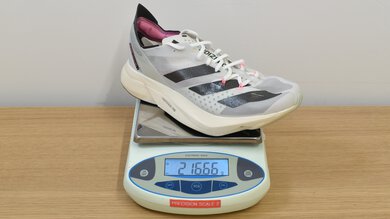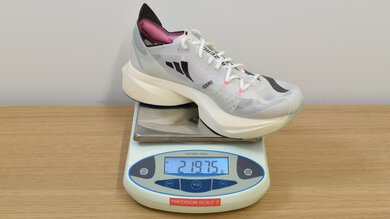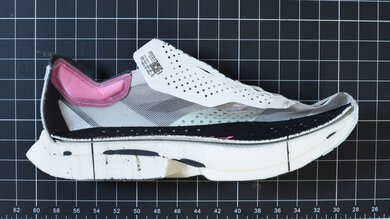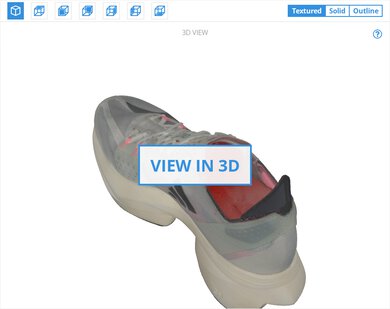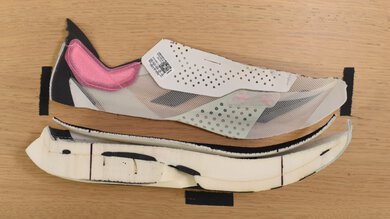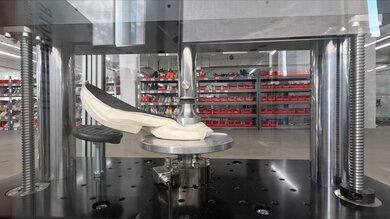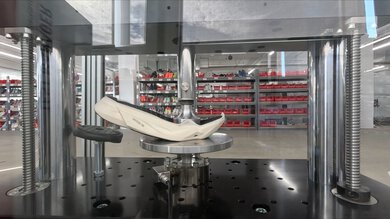The adidas Adizero Adios Pro 3 is a high-performance super shoe. It features adidas' signature Lightstrike Pro foam, paired with carbon ENERGYRODS that run parallel along the length of the shoe in place of a full carbon plate. The mesh upper helps to keep things light and cool during races, while the Continental rubber outsole offers substantial grip. Whether you're looking to shave time off your 10K PR or just need a premium shoe for intense interval sessions, the Adios Pro 3 brings a lot of tech to the table.
Our Verdict
The adidas Adizero Adios Pro 3 is a great choice for marathon racing, thanks to its lightweight design and impressive energy return. The shoe's substantial cushioning and carbon rods further enhance its suitability for long-distance events. However, its lateral stability isn't the best, which may require runners to exert additional effort to maintain balance over extended distances.
Good underfoot protection.
Carbon energy rods.
Very narrow arch due to cutout in the outsole.
Not the lightest race-day option.
For shorter races, the adidas Adizero Adios Pro 3 performs well, offering a firm forefoot that contributes to a snappy ride. Its lightweight construction and high-energy return make it a strong contender for shorter races, making it a solid choice for competitive runners.
Very snappy.
Forefoot is firm for toe-offs.
Carbon energy rods.
Not the lightest race-day option.
In terms of energy return, the adidas Adizero Adios Pro 3 is impressive, providing excellent responsiveness in both the forefoot and heel. This high-energy return translates to a more efficient stride, benefiting runners aiming for speed and endurance.
Very snappy.
The adidas Adizero Adios Pro 3's cushioning is very good, offering adequate underfoot protection. Both the heel and forefoot cushioning are good enough to absorb impact, contributing to a comfortable running experience.
Good underfoot protection.
Lateral stability is average on the adidas Adizero Adios Pro 3. This is mainly due to the narrow outsole arch width, a design choice made to minimize weight by cutting a part of the outsole. This design won't greatly impact you if you can maintain good form while transitioning. Also, the high stack height further affects balance during runs. While the carbon rods provide some structural support, runners will still need to focus on maintaining proper form to compensate for the shoe's limited stability.
Carbon energy rods.
Very narrow arch due to cutout in the outsole.
Performance Usages
Changelog
-
Updated Oct 23, 2025:
We updated the review to include text for the Forefoot Long Run Cushioning test, which was recently added to our test bench, and modified the Popular Running Shoes Comparisons box to include insights from that test.
- Updated Oct 23, 2025: We've converted this review to Test Bench 0.9, which adds a Forefoot Long Run Cushioning test to our performance section. Read more in our changelog.
-
Updated Oct 01, 2025:
We updated the Heel Energy Return, Heel Cushioning, Forefoot Cushioning, Heel Firmness, and Forefoot Firmness boxes to align with the latest test bench, refreshed the Popular Running Shoe Comparisons section, and revised the side-by-side comparisons to keep the review accurate.
- Updated Oct 01, 2025: We've converted this review to Test Bench 0.8.2, which updates our methodology for the impact force range used in our compression tests to improve their accuracy. This also affects all usage and performance usage boxes using those compression tests as score components.
Check Price
Differences Between Sizes And Variants
We tested the adidas Adizero Adios Pro 3 in men's US size 9, as indicated on the label. Out shoe's color scheme is Crystal White/Night Metallic/Linen Green. This model is also available in several other colorways, including Cobalt Blue/Zero Metallic/Lucid Lemon, Core Black/Zero Metallic/Spark, and Off White/Aurora Ink/Flash Aqua. Additionally, a Pink Y-3 version is available. Wide versions are not available for this model.
Popular Running Shoe Comparisons
The adidas Adizero Adios Pro 3 is a super shoe known for its great energy return and snappy ride, making it a strong option for race day. However, it lacks stability compared to most running shoes and even many other super shoes, such as the Saucony Endorphin Pro 4. While it's very snappy, there are stronger options for longer races, such as the Nike Alphafly 3, which provides better stability, a lighter feel, and maintains its cushioning more effectively throughout the run, all key factors for preserving efficiency in the later stages of a marathon.
Within the adidas lineup, the adidas Adizero Boston 12 may seem similar, but the Adios Pro 3 is the better choice for all-out racing, whereas the Boston 12 is more versatile, handling both training and some racing. Meanwhile, the adidas Adizero Evo SL offers great value and is an unplated uptempo trainer that's very bouncy and weighs just a single gram more.
For more options, check out our recommendations for the best running shoes.
The adidas Adizero Evo SL and the adidas Adizero Adios Pro 3 offer surprisingly similar performance. The Evo SL delivers comparable cushioning and energy return, making it an exceptional value option for those looking for race-ready features and true versatility. However, for peak racing performance, the Adios Pro 3 holds a slight edge thanks to its marginally lighter weight and full-length carbon fiber rods, enhancing efficiency.
The Saucony Endorphin Pro 4 and the adidas Adizero Adios Pro 3 are both high-performance racing shoes, but they cater to slightly different strengths. The adidas offers more cushioning and better energy return in the forefoot, making it feel softer and more efficient. In contrast, the Saucony is noticeably more stable and features a stiffer forefoot, which helps create a dynamic, snappy ride, especially beneficial for shorter races like 5Ks and 10Ks. Additionally, the Saucony is slightly lighter, giving it a more agile feel. Overall, the Saucony is probably the better race-day option for most.
The Nike Alphafly 3 and the adidas Adizero Adios Pro 3 are high-performance super shoes offering similar energy return and overall protection. That said, the Nike has a bit more cushioning, providing a more forgiving landing. The Nike also outshines the adidas shoe in lateral stability, thanks to its wider base. The adidas features a very narrow arch width, which can make it feel less stable. Also, the adidas is stiffer in the heel, while the Nike offers a softer feel. Runners preferring a firmer heel for more structure may lean toward the adidas, while those seeking a more cushioned landing may find the Nike more comfortable.
The adidas Adizero Adios Pro 4 and adidas Adizero Adios Pro 3 are both long-distance super shoes, but the Pro 4 brings some key updates. It's lighter, more responsive, and more cushioned thanks to a fully redesigned midsole. The upper was also reworked, resulting in a noticeably tighter fit in the forefoot. While neither shoe is the most stable, the Pro 3 was slightly more stable overall. The third version also has a firmer forefoot, which gives it an edge for shorter distances or runners who prefer a snappier toe-off.

We've recently started buying and testing running shoes with a very data-oriented approach. While we're just getting started, our methodology already has dozens of tests to help you make the right purchasing decision for your needs. Not only do we use high-end equipment to gather objective data, but we also order multiple sizes of the same shoes for team members to be able to log in miles. This real-world testing is done at various paces and conditions, and with different types of workouts, to cover all the bases. This allows us to verify our results and ensure they align with what you might feel with a specific pair.
Test Results

The adidas Adizero Adios Pro 3 is lightweight and suitable for racing, though notably heavier than some other models such as the adidas Adizero Adios Pro Evo 1. This extra weight will be noticeable for highly competitive racers aiming for a top-tier running economy.
Our outsole arch width measurement was taken from a slightly lower point on the arch of the shoe, when viewed from the outsole, due to an exceptional design cut-out on the medial side. We adapted our method slightly to better reflect the shoe's true stability profile.
The shoe delivers impressive responsiveness in the heel, translating into efficient energy transfer when transitioning during each footstrike. Runners will feel noticeable bounciness, which is especially beneficial over longer distances where energy efficiency is crucial.
This shoe shines in forefoot energy return, offering a great bounce. This makes it particularly effective for faster-paced runners who land more on their forefoot, enhancing performance during competitive races or speed-focused sessions.
The adidas Adizero Adios Pro 3 provides very good heel cushioning, giving runners a comfortable feel. While not plush, it absorbs impacts effectively at various forces, which is good for those seeking cushioning without sacrificing speed.
Forefoot cushioning in this shoe is very good, offering a comfortably firm feel that protects without compromising responsiveness. This cushioning strikes a good midpoint, benefiting runners who prefer a protective ride for faster-paced efforts. That said, runners who hit the ground with more force (typically faster and/or heavier runners) may notice less cushioning than with other options.
The heel of the adidas Adizero Adios Pro 3 is on the softer side. Under low forces, it's actually quite soft, but when more forces are applied (such as when you pick up the pace), the heel becomes a bit firmer. Still, it's not nearly as soft as some other super shoes like the Mizuno Wave Rebellion Pro 3.
Forefoot firmness in this model is notable, contributing positively to its racing performance, particularly for shorter races. Slower paces and lighter runners still get a touch of forefoot softness, but it firms up in a crisp, gradual way as forces build. This supports a quick, responsive toe-off, appealing to competitive runners who favor a snappy, responsive feel.
The adidas Adizero Adios Pro 3 delivers decent forefoot cushioning that gradually decreases over the course of a long run. Its absorption performance declines slowly, with no abrupt loss of protection, keeping it consistently comfortable through most of a marathon. However, the cushioning does thin out slightly in the later stages, meaning it feels a bit less protective toward the end compared to top-tier long-distance racers. For instance, the Nike Alphafly 3 starts out plusher and retains its cushioning more effectively, offering a slightly more forgiving forefoot at the 30-40 km mark.

